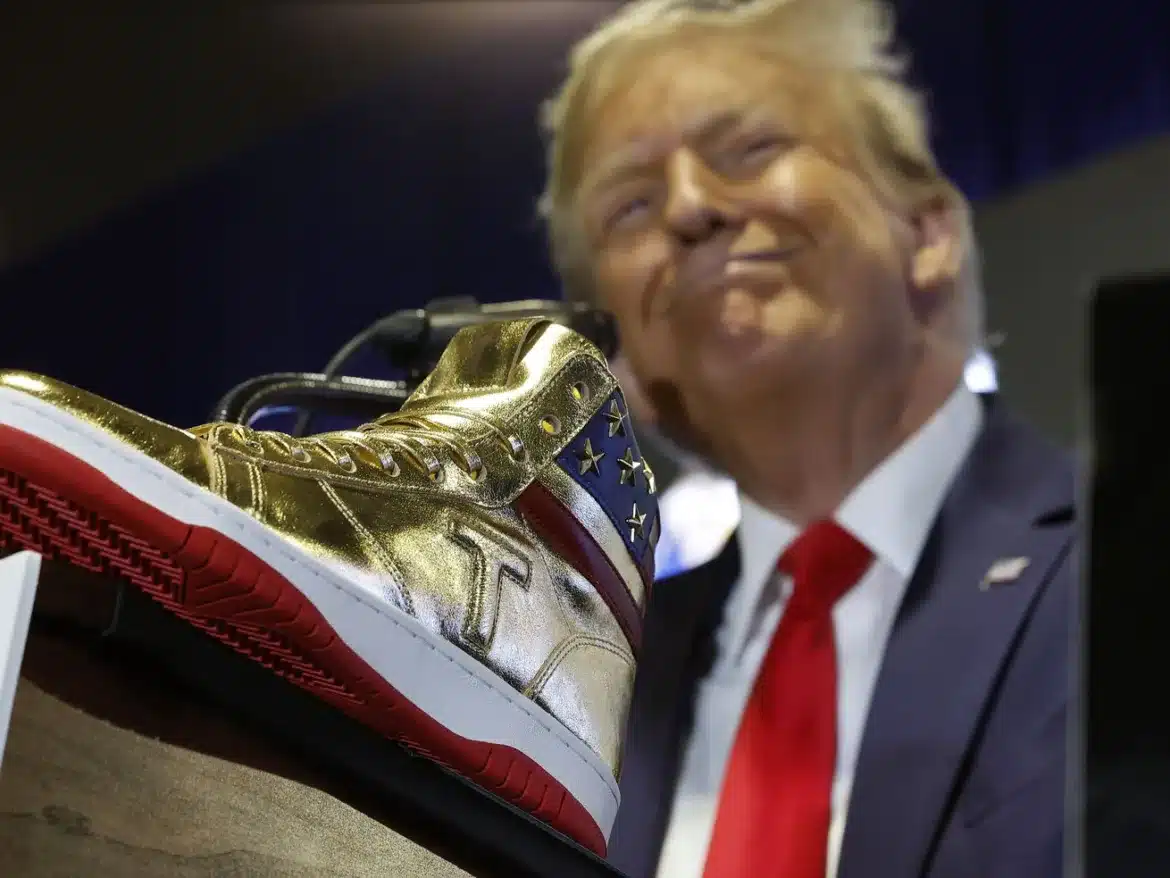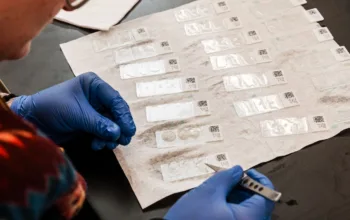A new book shows how conservative grift started long before branded bibles and $400 sneakers.
During his time atop the Republican Party, Donald Trump’s lifetime habits of fraud and grifting have fused seamlessly with conservative politics. In 2024 alone, Trump debuted $399 gold sneakers emblazoned with the American flag, sold a $60 “God Bless the USA” Bible endorsed by singer Lee Greenwood, and convinced millions to purchase stock in Truth Social’s unprofitable parent company.
Trump is often treated as a political hijacker who rerouted the Republican Party to his own self-interested ends. Surely that’s part of the truth. But at the same time, there’s a decent case that, when it comes to grifting, his hijacking attempt could only succeed due to the conservative movement’s ingrained scammy tendencies.
From paranoid anti-Communist lecture series in the 1950s to crowdfunded birther investigations to Alex Jones peddling fake coronavirus cures, there’s a long and storied history of elites peddling fear and paranoia to make a buck. The problem has gotten so bad that, in the past several years, many prominent conservatives have publicly bemoaned the omnipresence of grifts in the conservative ranks.
But where did this culture come from, and how important was it to Trump’s rise?
These questions are at the heart of The Longest Con, a forthcoming book on the history of right-wing scams and frauds. The book’s author, Joe Conason, is a veteran New York journalist; he personally knew some of the key figures in the scammy right’s history, like mobbed-up lawyer and Trump mentor Roy Cohn.
Conason locates the origins of the grift tradition with Joe McCarthy, whose anti-Communist campaign proved that paranoid lies could be a ticket to popularity on the grassroots right. Cohn, who worked for McCarthy, figured out a way to transmute that popularity into profit: exploiting fears of Communism to, among other things, finance a lavish trip to Europe.
/cdn.vox-cdn.com/uploads/chorus_asset/file/25375319/962171754.jpg)
Sonia Moskowitz/Getty Images
“The template for right-wing grift … followed in McCarthy’s wake,” Conason writes. “By creating such an atmosphere of utter dread — and then promising that they alone could prevent America’s doom — [hucksters] induced thousands of suckers to hand over large wads of cash.”
As the conservative movement grew, the grifts grew with it. Conason pinpoints Barry Goldwater’s 1964 presidential run as a key turning point. The campaign produced a massive mailing list that scammers could solicit for donations to alleged political causes that mostly lined their own pockets. When these “direct mail” scams proved immensely profitable, they expanded, normalizing an ethos of grifting on the right that, ultimately, would reach its apogee in Donald Trump.
I spoke to Conason about this fascinating, hidden-in-plain-sight history: about how it started, why it succeeded, how it paved the way for Trump’s rise, and whether there’s any equivalent grifting culture on the American left. What follows is a transcript of that conversation, edited for length and clarity.
Zack Beauchamp
So Roy Cohn. He starts his career as this corrupt New York lawyer, bridging the worlds of Democratic politics, high society, and mafiosos. When does he make the jump to the right, and how important is he in the rise of conservative grift culture?
Joe Conason
I think pretty important. The people who tolerated him for the longest time — William Safire, very respectable, Bill Buckley, very respectable. These people, they knew what Roy was. They knew he was a crook and a con man and a liar and a cheater, and yet, that was okay. To me, that was a sign of something very wrong in conservative culture, looking back, that that guy would be not only tolerated but celebrated.
As I say in the book, they would have big parties to celebrate him. Ronald Reagan had Roy to the White House, and when Roy was sick, they bent the rules to get him treatment that nobody knew about, even though he was pretending not to have AIDS. Roger Stone, who became very powerful in the conservative movement, was a protégé of Roy’s.
He had some kind of charm or attraction or something for these conservatives, who otherwise I think would’ve told you that they themselves would never contemplate doing the kinds of things that Roy did, which is basically stiffing the IRS for 20 years or 30 years or however long it was, and not paying his creditors, which is a thing that Trump seems to have picked up from him.
He was a rogue, and I think [they thought] “Oh, he was a roguish fellow. Wasn’t he fun?” But at some point, you catch a little of the disease yourself. And I think the willingness to overlook Roy’s deep, deep corruption was — let’s just say it was a bad sign. I can’t tell you that that caused anything, but it was not a good sign about the moral character of that movement in its earliest days.
Zack Beauchamp
Let’s talk about the expansion of this, because obviously, grifting in the conservative movement isn’t just a Roy Cohn story — though he was a pioneer in some of the earliest versions of these ways of grifting, about selling fear of communism.
Joe Conason
In the aftermath of McCarthy, the impulse and the marketability of anti-communism as an ideology did not go away. To turn it into a business, you would sell lectures. There were a series of them that I profiled in the book that had different ways of marketing a hysterical version of anti-communism to middle-class and upper-middle-class people who were terrified. They would pay a lot to go to a lecture, they’d buy lecture tapes, they would buy books. It could cost them hundreds of dollars, which in 2024 dollars is thousands of dollars.
This got so bad that J. Edgar Hoover — who was considered the greatest authority on communism on the right, had a whole apparatus to root out communism in the country — was appalled by these people. I found communications between Hoover and his deputies about some of these individuals they thought of as grifters and con men and crooks, and they investigated them. That’s how bad it was: J. Edgar Hoover thought “these guys are crooks and they’re giving anti-communism a bad name.”
Zack Beauchamp
During the Cold War period, how central was the grifting and con man stuff to the conservative movement? The standard history is that, sure, maybe there were some cranks on the side, but Ronald Reagan and William F. Buckley defined a new and principled way of thinking about American politics.
Your book offers an alternative history, positioning the profiteering and swindling as something that grew with the post-war conservative movement. Just how deeply intertwined is the grift with the more committed side of the movement?
Joe Conason
What I would say is that the grifting side — the side that doesn’t really believe in anything very much except its own enrichment — has grown. It wasn’t necessarily the dominant portion in the beginning at all. But there’s a point in the book where Richard Viguerie discovers direct mail and how he can use the Goldwater movement [in 1964] to build a huge direct mail industry. I’d say that was a turning point.
Richard Viguerie was a guy who had been brought into the direct mail business with the Buckley crowd — Young Americans for Freedom, which was their central organization, aside from the National Review, for raising money. He realized that you could just ask people for money and they would give it to you.
Zack Beauchamp
You don’t even need to be selling them anything physical, right? That’s the innovation here, you just send them a mailer promising to fight for what they believed in.
Joe Conason
Yes. But the problem was that in order for that to be really effective on a national level, you needed lists of names. And lists of names of conservatives just didn’t exist until the Goldwater campaign in 1964. Viguerie realized that the donors to the Goldwater campaign comprised a national list of conservatives who would donate money. He said [it] was like a key to Fort Knox. It turned out he was right: Those people would give money. And it built from there.
People who are giving you money don’t really know what you’re doing with the money. You’re telling them you’re doing this and that, and maybe you are and maybe you’re not. In many cases not, and they don’t have any way of knowing.
What they know is that they have grievances and concerns that you’re addressing, or you’re telling them you’re addressing. They’re willing to give money to make themselves, I guess, feel better about that.
Now, it took a while for it to take over. But once that starts, it was impossible to stop. It takes over a larger and larger portion of the conservative movement, to the point where we now have Trump.
One of the reasons I wrote the book is you can see how, over time, this impulse to swindle and grift became a bigger and bigger part of conservatism. And the honest conservatism — the ideological and philosophical [principles], what they considered moral virtue — has been stripped away.
Zack Beauchamp
So you just jumped from Viguerie in the ’60s all the way forward to Trump in 2016. There’s a wealth of time during which this spreading happens. What are some of the key events in between, the ones that fueled the rise of right-wing grift culture?
Joe Conason
It takes different forms over time. One is the religious right: Jerry Falwell, the Moral Majority, Pat Robertson, the Christian Coalition. Now the Prosperity Gospel types who are around Trump, who are just straight-up grifters. That becomes a big element in it.
Then you have the Reagan administration, which I describe as the most corrupt in history — up until Trump at least — in terms of the number of prosecutions and scandals. There were quite a few people who found ways to profit from government programs that they were supposedly going in there to end or reduce.
One of the most interesting is Paul Manafort, who turns up much later as Trump’s campaign manager. James Watt was another. A Western conservative who supposedly was against big government, he was just finding ways to get paid off and almost went to prison for it.
Then we come to the period just before Trump arises: the Tea Party and the birther movement. That too was a grift: There were certainly grifters getting people to give them money to prove that Obama shouldn’t be president or was not qualified to be president, but the lead figure in that was Trump. And so, logically, Trump becomes a force within the Republican Party, and meanwhile, the Republican Party is kind of losing its way in general and becomes very vulnerable to someone like him.
Zack Beauchamp
What I think is novel here in your book is seeing this history as laying a unique kind of pathway for Trump. You had these generations of people who built an expanding empire of profit grafted onto conservative ideology, and then Donald Trump comes along and he’s like, “Wait, I can just make the movement fully into that — an extension of my efforts at brand-building.” That’s a core part of what allows him to succeed in Republican politics: that brand-building and profiteering have already been built into it over the course of decades.
Joe Conason
I would point out that the creator of Trump, in a lot of ways, is Roger Stone, who’s been in the grifting business of conservatism for a really long time. Stone saw that Trump was a really outstanding possibility for the kind of politics that Roger represented, which was a hollow politics of demagoguery with more than a touch of racial paranoia and hate, and that could be perfectly flexible in terms of positions and issues and viewpoints and rhetoric.
Roger got to know Trump during the first Reagan campaign through Roy Cohn. And he figured out this was a guy who had real potential. They had a model, a way of conducting themselves politically that was both effective on a certain segment of the public and highly profitable. They had thought about it for many years before Trump finally agreed to run for president.
Trump was a perfect candidate [because] he had shown he would get involved in any kind of grift. He’d gotten involved in multilevel marketing. Trump University was a type of scam: the fake real estate investment seminar, which would get people to pay big money and promise them that they would make a lot of profit on real estate themselves. Trump had a perfect brand to get into, and so he did.
Roger Stone and others around him realized, “Hey, this is our guy. We can capitalize all of this that’s been built in the past and discard anything that’s inconvenient about conservatism because who cares?”
Zack Beauchamp
So now, we get the leading Republican presidential candidate hawking multi-hundred-dollar sneakers and an America-themed Bible as a means of making money — a full integration of political party with scam ventures. There’s nothing like this level of mainstream hucksterism on the Democratic side, as far as I can tell.
Joe Conason
In writing the book, I went out and looked for examples of this on the blue side. I think people get swindled by all kinds of things all the time, whatever their politics are.
Zack Beauchamp
I think you have some pretty solid examples of people on the left in your introduction who have grifted liberals. We can also talk about the Democratic machines in cities that are less ideological and more focused on maintaining power.
Joe Conason
Look, we have a Democratic senator right now who’s [been indicted for] hiding gold bars.
Zack Beauchamp
Right.
Joe Conason
I would never pretend that corruption or mendacity or greed is confined to the right, and I hope I didn’t give that impression in the book. But there are certain themes on the right that seem to lend themselves to these kinds of crooked schemes.
Roger Stone said long ago that one of his rules of politics is that hate triumphs over love in politics, that hate is the most saleable thing in politics. All of his campaigns have been based on that rather curdled insight, and a lot of the merchandising comes down to that as well.
It’s what they now call “own the libs,” but it’s been the same emotion for decades and decades now.



